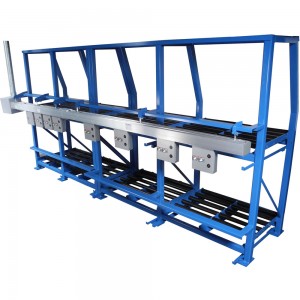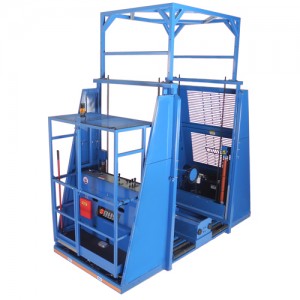We use cookies to make your experience better. To comply with the new e-Privacy directive, we need to ask for your consent to set the cookies. Learn more.
Lift Truck Battery Solutions: Fast Charge Technology vs. Optimized Battery Handling Equipment
Introduction: Fast Charge Batteries and Lift Truck Fleets
Because they eliminate the need for battery changes, fast charge systems are initially an attractive option for many warehouses and distribution centers that run multiple shifts per day. However, several disadvantages -- including significantly higher capital costs and shorter battery life spans -- make conventional battery handling systems a more cost-effective option for the vast majority of operations.
This white paper will discuss the disadvantages of fast charge forklift battery systems as an energy solution for lift truck fleets, focusing primarily on the costs associated with the technology, and address the use of battery handling equipment as a more effective alternative. The paper concludes with suggestions for implementing best practices with battery handling equipment, eliminating the need for wide-scale infrastructure replacement while achieving a similar set of benefits.
Matching the Technology to the Facility

Figure 1. The BHS Electrical Distribution System (EDS) routes power to chargers and other equipment, and can be customized to fit any facility.
No technology offers the same return on investment in all applications, and facility managers should always evaluate the factors that affect operative productivity before making substantial changes.
Forklift fleet management consultants recommend evaluating the following factors before selecting a battery charging technology for electric lift trucks:
- Lift truck operating hours per year.
- Number of shifts per day.
- Capacity of the facility’s electrical service.
- Facility energy usage over time.
Measuring these elements can help to determine how to effectively improve productivity while limiting the expenses associated with materials, infrastructure and electrical consumption. Fast charge systems place greater demands on electrical systems, and effective training programs must be in place to realize the full benefits of fast charge technology.
According to fleet management specialist Scott McLeod, writing for MHL in 2010, “the average lift truck and battery technician likely won’t be up to speed on all the elements necessary to service and maintain this system for optimum performance and the lowest cost.” The ideal fast charge facility must have the opportunity -- and available personnel -- to engage in more extensive training.
Smaller operations are generally not good candidates for fast charge systems. Facilities that run their fleets for a single shift per day leave ample time for the charging and cooling cycles that optimize output for the traditional lead-acid forklift battery. Fleets that can recharge their batteries overnight only need a single conventional battery for each truck, which eliminates the main advantage of fast charging.
When running multiple shifts, however, operations will require at least two traditional lead-acid batteries for each forklift. Given appropriate battery management systems, these operations can reach peak efficiency without transitioning to fast charge technology.
Technical Considerations
The difference between fast charge batteries and conventional forklift power systems is largely a question of design. Both use lead-acid cells to generate energy -- the main difference is that fast charge batteries are equipped with more costly cooling and monitoring functions and doubled connectors between cells. While the batteries are not fundamentally dissimilar, charging devices do differ greatly between the two technologies.
Differences Between Fast Charge and Conventional Chargers |
|||
| Type of Technology | Cost of Purchase | Power Output | Time to Reach Preferred State of Charge (SOC) |
| Conventional | $2,000.00 | 5 kW | 8 hrs. (100% SOC) |
| Fast Charge | $11,000.00 | 15-30 kW | 1-2 hrs (80% SOC) |
Figure 2. Specifications for competing charging devices. Source: SAE International and MHI./p<>
Fast charge technology realizes shorter charge times by dramatically increasing the flow of electricity, creating a much greater draw on the electrical grid. Managers should ensure that the electrical service at their facility is sufficient to handle the increased amperage necessary to use fast charge devices before considering conversion. Even so, this significant increase in electrical costs certainly affects the long-term return on investment.
Original Equipment Manufacturer Claims
Manufacturers of fast charge batteries and chargers often suggest that the technology offers increased productivity and a quick return of investment -- as low as less than half a year, according to one estimate. In practical situations, this is an unrealistic expectation due to a few key assumptions.
Proponents typically point to the following conditions to promote fast charge systems:
-
Number of Required Batteries.
Because fast charge systems only require a single battery per lift truck, operations that run multiple shifts can get by with fewer batteries. However, the added material costs and shorter operating life spans limit this benefit, as fast charge systems require more frequent replacement of more expensive batteries.
-
Productivity Claims.
Some consultants estimate a 75 percent reduction in charging time with fast charge technology. This is ostensibly the time that the trucks can contribute to overall operating productivity, but with multiple batteries per truck and efficient battery handling systems, conventional batteries are no less productive.
-
Estimated Returns on Investment.
Estimates on ROI from manufacturers vary from six months to two years. The metrics that go into most manufacturer estimates are based on assumptions that do not apply to many operations, and many estimates assume substandard battery management systems.

Figure 3. The BHS Triple Stack Battery Extractor (BE-TS) optimizes floor space, providing additional square footage for valuable storage and warehousing functions.
A Closer Look at ROI Reports
One report on the benefits of fast charge technology estimates a complete return on investment in 0.47 years, but this estimate relies on inaccurate assumptions. According to the study, fast charge technologies provide benefits by eliminating battery changing, re-assigning battery real estate and re-assigning a dedicated battery room attendant. The savings in productivity assume that changing a battery requires 20 minutes with a labor rate of $25/hour. Under this calculation, each battery change costs an operation $8.25. In a facility running two shifts per day, this would add up to a daily cost of $16.50 per lift truck.
However, with adequate battery handling equipment and an efficient charging room, change times are typically closer to 3-9 minutes. Assuming a median change time of six minutes at the $25/hour rate, each battery replacement costs only $2.50, or $5.00/day for an operation running two shifts -- over a third lower than the estimate.
The savings calculation in question assumes that all fast charge deployments complete charging tasks during times the forklift is assumed to be idle, such as breaks or shift changes. This does not account for the finishing and equalizing charges that each fast charge battery will require, which lead to a minimum of eight hours of idleness per machine, per week.
The assumption of a battery room attendant is also contingent on the particular operation, as in many warehouses drivers change their own batteries. Even if an operation employs a battery room attendant, reassigning the staff does not necessarily translate into direct savings of the employee’s labor rate as this calculation assumes.
The final metric used to calculate savings in this example -- eliminating the space required by charging rooms -- can be achieved more efficiently by utilizing space-saving battery handling equipment, such as double-, triple-, and quad-stack battery extractors and multi-tier charger stands.
Disadvantages of Fast Charge Technology
Due to significantly higher implementation costs, fast charge systems would require extreme advantages over conventional charging services in order to provide an attractive return on investment. When compared to updating battery handling equipment, there are several marked disadvantages that limit the efficiency of fast charge technology.
-
Shorter Battery Lifespan.
Increased temperatures and the greater consumption of active materials in the fast charge battery lead to a shorter average life -- three years or fewer, compared with four to five years for conventional batteries. With the best standards of care, some modern conventional batteries can last as long as eight years.
-
Greater Cost of Implementation.
Because quick charge batteries are more expensive per unit, their shorter lifespan leads to higher replacement costs than conventional lift batteries.
According to forklift consultants Fleetman Consulting, fast charge batteries cost an average of 1.5 times the price of a conventional battery. When added to the price of the faster chargers, which can be five times more expensive than traditional chargers, and the overall cost of conversion expands significantly.
-
Greater Demand on Electrical Supply.
With the higher charging current used by fast charge systems, facilities might encounter increased electricity costs or even inadequate electrical infrastructure. Facilities that limit charging to overnight chargers can also capitalize on off-peak electricity rates.
Conclusion:
With shorter battery life spans and a comparatively high price tag -- as much as five times higher per charger in some instances -- fast charge systems demand a heavy cost for relatively modest productivity gains.
For operations with existing battery infrastructure, upgrading battery handling systems can improve productivity without transition costs. Better management helps to increase efficiency with the current generation of conventional batteries, allowing for more substantial benefits and a better overall investment.
The following techniques can improve the battery handling practices of most operations:
-
Maximize Energy Efficiency
- Proper battery management can reduce energy costs substantially. One California utility company recommends charging forklift batteries during off-peak hours and offers incentives to warehouses that comply; these incentives can help to further reduce the costs of charging.
In addition to claiming utility discounts, implementing a comprehensive management system can extend battery life and help to achieve optimal efficiency. For example, the BHS Fleet Tracker incorporates a first-in, first-out protocol and tracks charging data, generating detailed reports that managers can use to fine tune their operations.
-
Eliminate Over-discharging
- Draining a battery to below 20% power drains overall capacity over time, and regular over-discharging can shorten the battery’s lifespan considerably. This operational inefficiency can be avoided by employing a monitoring system such as the BHS Next Available Battery (NAB-2000), which tracks the charge of every battery in the fleet.
-
Use Space Efficiently:
To maximize square footage devoted to warehouse operations, battery rooms can be set up with space-saving equipment. For instance, vertical charger stands limit floor space requirements, while double-, triple-, and quad-stack battery extractors allow even larger fleets to keep a smaller battery room.
Lead-acid batteries remain the industry standard for powering electric lift trucks, and longer charging times equate to longer-lasting batteries. Fast charge technologies may provide limited benefits for operations that are losing productivity to inefficient battery changing operations, but improving protocols and equipment are a much simpler -- and more cost-effective -- solution.
References
Bond, Josh. “Lift Truck Management Tips: Power Options -- The hunt for operational efficiencies.” logisticsmgmt. Logistics Management, 1 January 2013. Web. 11 Feb. 2015.
“Efficient Forklift Battery Charger.” pge. Pacific Gas and Electric Company, 2009. PDF File. 12 Feb. 2015.
“Fast Charge Technology for Electric Lift Trucks.” cat-lift. MCFA, 2012. Web. 11 Feb. 2015.
Gooley, Toby. “Battery room confidential.” dcvelocity. DC Velocity Magazine, 2015. Web. 14 Feb. 2015.
Jerram, Lisa. “Lead-acid rules as forklift battery, but alternatives pursued.” sae. SAE, International. 1 May 2014. Web. 11 Feb. 2015.
Kutkut, Nasser. “Fast Charging Facts: Enhancing use of electric lift trucks, AGVs, and other motive electric vehicles.” mhi. Power Designers USA, LLC. n.d. PDF File. 11 Feb. 2015.
Liew, Christine. “Fast charging - what is it?” forkliftaction. Forkliftaction Media Pty. Ltd., 23 March 2006. Web. 11 Feb. 2015.
McLeod, Scott. “Forklift Fast Charging: the Positives and Negatives.” MHLNews. Material Handling & Logistics, 1 Nov. 2010. Web. 11 Feb. 2015.
McLeod, Scott. “Fast Charging for Lift Trucks aka Forklifts.” fleetmanconsulting. Fleetman Consulting, n. d. Web. 11 Feb. 2015.

